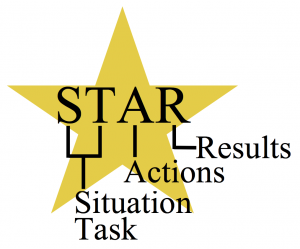Behavioral interviewing tip #4: Give STAR responses
Previous posts in series:
- Behavioral interviewing tip #1: Use results to demonstrate past successes
- Behavioral interviewing tip #2: Prepare stories from your career based on the job description for the position you want
- Behavioral interviewing tip #3: Research the company and its industry and products
As the name suggests, behavioral job interviewing is all about learning what behaviors you have exhibited in the past in your career. Good or bad, past behaviors are an excellent indication of how you will behave in the future on the job.
A well-prepared interviewer will have questions prepared in advance, as well as a scoring system to grade your responses. Since the interviewer will have a strategy in place, you need to have one too. The posts in this series are all about being prepared so you can shine in the interview!
So how can you effectively present your past behaviors? “STAR” is a simple but effective mnemonic that’s been around awhile. It’s an acronym for Situation/Task, Actions, Results. First you describe a situation you faced or task that was given to you. Next, you describe the actions you took. Finally, you describe the results you achieved.
The difference between “situation” and “task” in STAR is worth mentioning. In “situations,” you have more power to solve problems and pursue opportunities your own way. Part of the creativity involved may be recognizing that there is a situation in the first place. “Tasks,” on the other hand, are typically assigned to you to do in a predetermined way. Even with tasks, however, there is plenty to talk about: you can describe how you applied your skills effectively, invented new ways of performing the task, or even discovered how to eliminate the task completely to improve efficiency.
Let’s give an example of a typical behavioral job interview question and how a candidate could provide a STAR answer:
Q: Our salespeople are expected to find creative new ways to build their territories. Tell me about a time you used your creativity to build sales.
A: [Situation.] When I first joined the company, I was managing five in-house salespeople, whose morale was very low. They did the bare minimum and went home for the day. But I saw a lot of potential in them and knew we could do better. [Actions.] So I thought, “How can we make this fun?” I had a budget for incentives that we weren’t using. I asked the team members what incentives they would find fun. Everyone was interested in taking a trip to Cedar Point, and that fit the budget perfectly. So I said, “If we can double both the team’s call volume and sales volume, we will all take a two-day trip to Cedar Point.” I put a big graph out for everyone to fill in their number of calls each day. [Results.] The change in morale was instantaneous. Everyone got in the groove and started having real fun with their work. Call volume went up 60%, and sales volume went up 75%. In addition, the team started establishing their own incentives and sales goals. One small change made a big difference.
STAR is all about telling stories about your career in an effective way. With this simple pattern in mind, you can approach the interview with a lot more confidence!
Matt
The Key Corporate Services Blog Team

